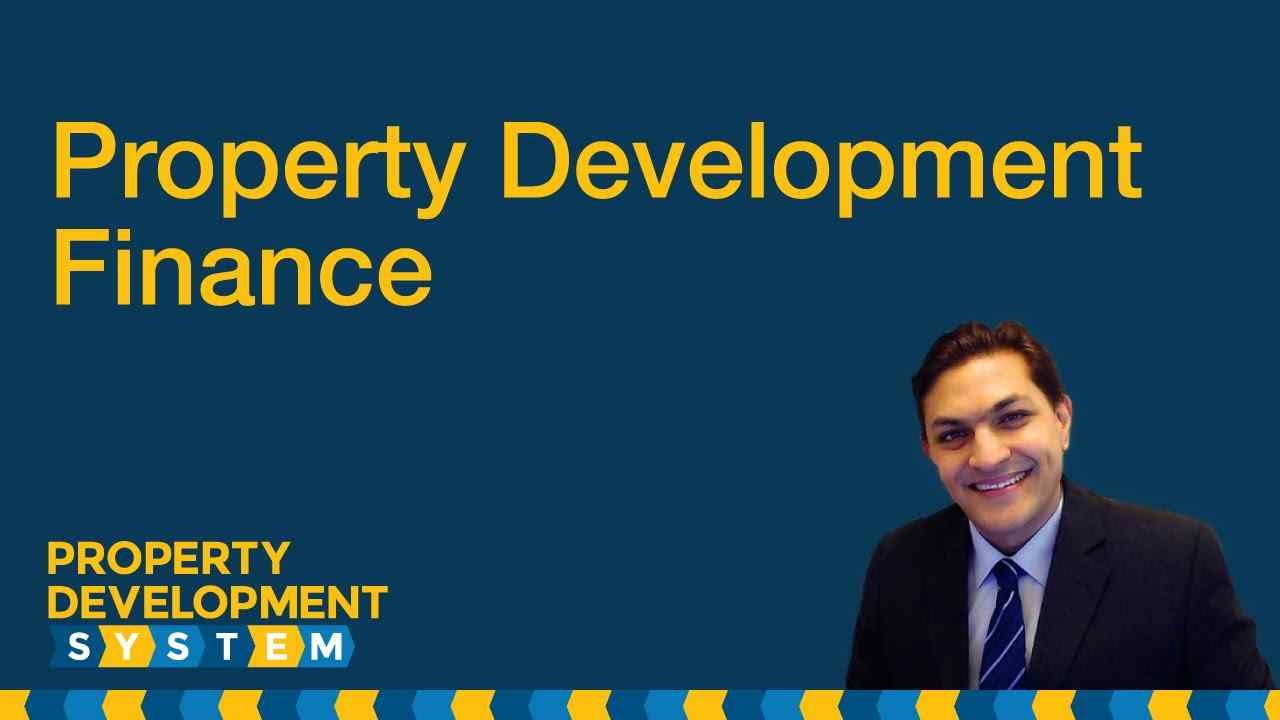Ultimate guide to property development funding
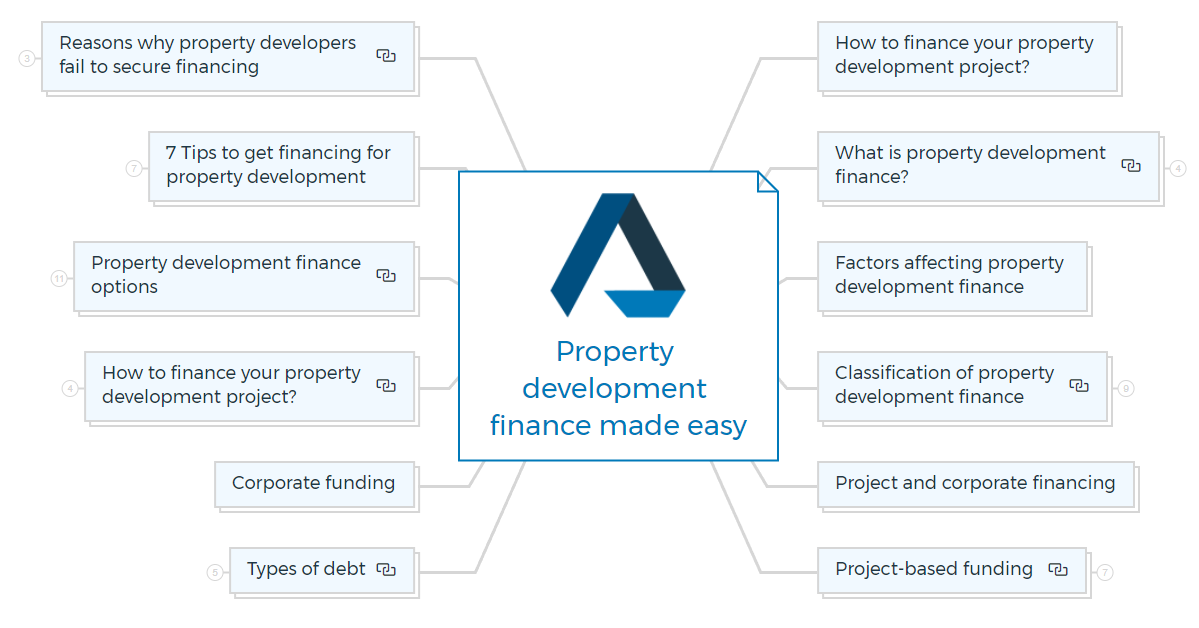
How to finance your property development project?
Property Development Finance is very different from normal retail finance. However, in order to understand it correctly, you must first understand how commercial real estate finance works.
If you are new to Property Development, I would recommend that you first read the following three articles as the information in these articles is interrelated and you will understand the property development finance section much better if you understand the Property Development Process first.
- Ultimate Guide To Getting Started In Property Development
- Property Development Feasibility Study &
- Our Property Development Books
To begin with you need to understand the classification of property development finance. Finding a real estate deal requires a proper understanding of property development financing.
Investing in real estate can provide a steady passive income, but it requires investing large sums of money, which people like me and you don’t always shave. Hence the need to leverage off lenders so you can maximize the return on your investment.
What is property development finance?
Property development financing is the process by which real estate developers or investors receive funding to purchase & develop a target property.
Property development finance has a plethora of creative options available, but most of them fall within equity or debt financing. Debt and equity financing options have their advantages and disadvantages.
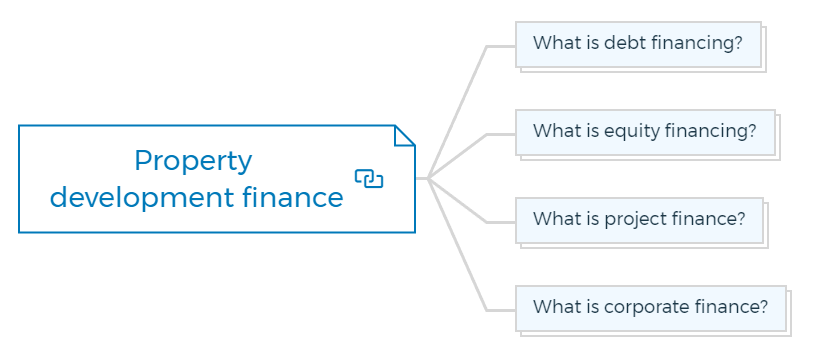
What is debt financing?
Debt Financing is defined as loans obtained from banks and other sources against a project or non-project-specific loans obtained from the market. It happens when an individual or organization takes out a loan to buy a property.
The loan is subject to specific underwriting requirements and accrues interest in addition to the principal payment.
What is equity financing?
Equity Financing refers to funds and resources contributed by the developers, partners, investors, and funds participating in the scheme's risk and profit.
This form of financing is typically available to Institutional Investors, but it can be a valuable method to diversify your portfolio. I have already shared my secret strategy to generate equity fast that you can use for your upcoming property development project.
The lines between debt and equity are sometimes blurred as corporate financing, raising funds against a company's assets, can be done using both equity and debt.
Before you explore the major categories of real estate financing, you should learn a little about project and corporate finance.
What is project finance?
Project Finance is a type of financing in which the property serves as the primary or exclusive security for the loan; however, it may require supporting guarantees and additional collateral.
What is corporate finance?
Corporate finance refers to the raising of funds on behalf of a firm rather than a project.

Get The Edge Now!
Discover the transformative power of our FREE EDGE platform and
unlock a world of opportunities at no cost!

Your Real Estate Toolkit Awaits!
Free eBooks, Courses & Feasibility Suite Trial—Join Today!
✓ Unlimited FREE Trial: Experience the full power of our Feasibility Suite with hands-on demos
—explore without limits, no time pressure & without commitment or credit card!
✓ Learn from Success: Dive into real-life case studies for practical insights.
✓ Engage, Inquire, and Innovate: Ask questions, request features, and engage in lively discussions.
✓ Showcase Your Projects and Gain Insights: Share your projects and get personalised feedback.
✓ Free Resources Galore: Access a treasure trove of free resources,
eBooks & courses to keep you informed.
✓ Exclusive Training: Enjoy members-only training to sharpen your skills.
Factors affecting property development finance
Consider the below variables for determining whether to proceed with development from a financial standpoint:
- Inflation
- Interest rates
- The status of the economy (timing) the flow of the money supply
Remember - An increase in interest rates usually results in an increase in capitalisation rates, which leads to a decrease in market prices. This has a particularly negative impact on commercial property.
Borrowers are often confused by the variety of real estate loan options available. Therefore, they must evaluate the interest rate, the establishment fees, annual administration fees, early repayment penalties, and the cost of refinancing arrangements if necessary.
Classification of property development finance
There are different types of property development finance that you should know before signing a deal.
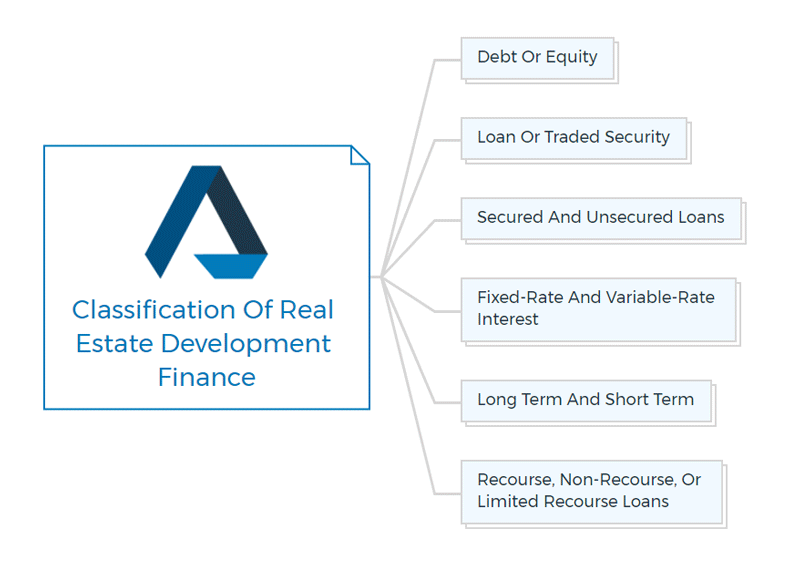
Debt or equity
The difference between debt and equity is whether the money is borrowed (debt) and the borrower has no direct involvement in the project or whether the money is provided on the grounds of sharing both the business's risk and rewards (equity).
A borrower needs to repay the funds, and interest will be charged on the outstanding balance until the loan is paid off completely. The success of the business determines the equity return for the person who put up the money.
If there are profits, the person shares them, and if there are none, there is no return.
Cash subscribed as ordinary share capital is the most apparent type of equity. Equity shares are also possible in development situations where a financier can receive a share in the profits.
Convertible loans, for example, are a type of deferred equity. These loans start as debt with a fixed rate of return and later change into equity shares.
Acquisition financing, SBA loan, private lender, Bridge loan, Mezzanine financing are common forms of debt financing.
Loan or traded security
Borrowed money can be a simple loan or borrowed by allowing investors to subscribe for a bond, resulting in a transferable piece of paper. Instead of a simple loan, this is a type of IOU note known as a security.
Investors can trade this security to other investors. Investors earn interest each year in exchange, and the actual money is refunded after the security's agreed period.
They can also sell their rights to investors if they don't want to wait for the repayment date. In this case, they will be entitled to the interest and eventual repayments. These securities can be bought and sold on a stock market.
Secured and unsecured loans
Understanding the differences between the two is a crucial step toward financial literacy, and it can have a long-term impact on your financial well-being.
A secured loan requires that borrowers provide collateral. An unsecured loan doesn't. This difference can affect your interest rate, borrowing limit, repayment terms, and other factors.
A valuable asset backs a secured loan. As collateral, the item bought, such as a house or car, may be used. Until the debt is paid, the lender will keep the title or deed.
Stocks, bonds, and personal property can also be used as collateral. If you don't pay back the amount in a secured loan, the lender can sell your collateral to cover the debt.
Mortgage, Home equity line of credit, auto loan, boat loan, recreational vehicle loan are examples of secured loans.
Student loans, credit cards, and personal loans are examples of unsecured loans. As there is no asset to reclaim in the event of default, lenders incur a more significant risk by issuing this loan. The interest rates are therefore higher.
Secured loans may still be available to you even if you are turned down for unsecured credit. However, you must have something valuable to utilize as collateral.
Although a secured loan is safer than an unsecured loan, well-established corporations may raise unsecured loans since the lender's protection is the company's available profit record used to pay the interest.
Fixed-rate and variable-rate interest
A fixed-rate loan has a fixed interest rate for the duration of the loan, whereas a variable rate loan has a rate of interest that fluctuates over time based on money market movements.
Fixed-rate loans are preferable for persons who want predictable payments. They won't increase or decrease in cost.
Variable-rate loans have varying interest rates. This means that the cost of variable-rate loans will fluctuate over time. Borrowers who expect lower interest rates prefer variable-rate loans. This type of loan is often used to fund short-term needs.
A fixed-rate is more common for long-term borrowings, such as mortgage debentures. For floating rate borrowing, the borrower may opt for a cap, an insurance policy that sets a maximum limit on the interest rate that a borrower needs to pay, regardless of general interest rates.
Long term & short term
To create money and gain experience in real estate investing, investors might employ long-term and short-term strategies.
One to two years is often considered short term by many people. This is the equivalent of the development period for most projects. Two to seven-year are considered medium-term. Seven years or more are considered long-term.
Purchase and rehab, often known as fix-and-flip, is an excellent short-term technique for transferring funds to the new properties. Long-term investing is another alternative, which often involves a 30-year loan and passive income.
Long-term rental (30 years) is a great way to generate passive income. This method requires less work upfront than a typical fix-and-flip project. Buy and hold is a long-term investment strategy that many property developers employ.
This technique provides a plethora of opportunities to learn valuable skills. Property management, professional relationship building, market research, tenant selection are skills you can learn through this strategy.
Recourse, non-recourse, or limited recourse loans

Recourse loan
The lender has recourse to the parent company's assets if the parent company guarantees the loan for a specific project or subsidiary firm.
Non-resources loan
The loan is non-recourse if the only security for the lender is the project itself, as in a pure type of project-based finance, and the parent business has provided no assurances.
In reality, a non-recourse loan is doubtful to be approved because banks often require limited recourse loans. The parent may have guaranteed interest payments but is not obligated to return the debt in some instances.
Limited recourse loan
A limited-recourse loan would still be based on the borrower's reputation and the company's track record, as well as the project's quality.
I gave you a brief overview of the project and corporate financing at the start of this article. Let's dig a little more and look at how the project and corporate finance are handled, as well as the fundamental differences between the two.
Project and corporate financing
The money borrowed to finance a project is called project finance and is used mainly for development projects. The project itself serves as the primary security for the loan.
Larger companies may be able to borrow against the strength of their assets rather than individual projects. This is corporate finance. Because there is more collateral to secure the loan than one project, interest rates for corporate loans will generally be lower than those for project loans.
Sometimes, even large companies can undertake development projects that exceed their resources. The developer may be worried that if the project fails, the lenders may have recourse to the company's other assets, thereby affecting its finances.
This could mean that each development would need to be funded separately, and companies might try to make the project "off-balance sheet."
Get The Edge Now!
Discover the transformative power of our FREE EDGE platform and
unlock a world of opportunities at no cost!

Your Real Estate Toolkit Awaits!
Free eBooks, Courses & Feasibility Suite Trial—Join Today!
✓ Unlimited FREE Trial: Experience the full power of our Feasibility Suite with hands-on demos
—explore without limits, no time pressure & without commitment or credit card!
✓ Learn from Success: Dive into real-life case studies for practical insights.
✓ Engage, Inquire, and Innovate: Ask questions, request features, and engage in lively discussions.
✓ Showcase Your Projects and Gain Insights: Share your projects and get personalised feedback.
✓ Free Resources Galore: Access a treasure trove of free resources,
eBooks & courses to keep you informed.
✓ Exclusive Training: Enjoy members-only training to sharpen your skills.
Project-based funding
Project finance can be a helpful instrument for smaller property development firms that do not access the stock market. The current assets may fully secure the loans in certain situations.
The companies' financial situation may potentially not give enough security for the financier.
The following types of financing are typically provided for project funding:
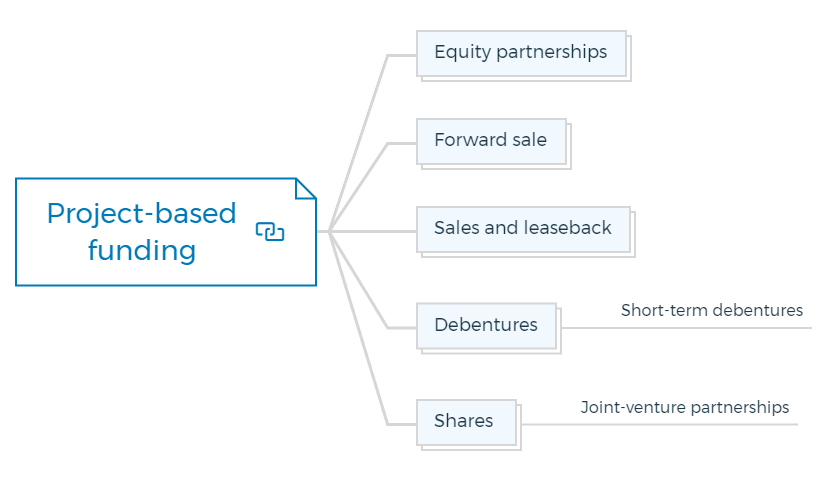
Equity partnerships
A share of profits (equity) is an incentive mechanism used to structure an Equity Partnership arrangement with a Real Estate project. Experienced investors are always willing to contribute money to a successful real estate transaction.
Equity partnerships is a type of development financing that includes arrangements like participation lending and forward funding.
In participation lending, the lender receives a portion of the scheme's proceeds, and this may occur when a lender is willing to take a higher risk by lending more or at more favorable rates.
Forward funding is when a buyer of development contributes to the development's funding. This action assures the buyer that he will have some control over the development project as it progresses. The forward funder may finance the project at a lower interest rate.
Forward sale
A forward sale contract can encourage short-term funds because the bank will know it will get its money back within a specific time frame. Alternatively, the entity that is offering the forward sale contract could also be providing bridging finance.
Pre-funded projects often require an upfront commitment by the institution to purchase the development upon completion. The agreement would be that the institution regularly extends interim credit at a lower interest rate than the current market rate.
When construction is finished or the building is leased, the institution purchases it by paying the purchase price minus the total development cost and rolled-up interest.
Learn the secret and improve the skills of making a no-money-down property development deal.
Sales and leaseback
A developer sells a completed project to an investor and concurrently takes back a long lease at an agreed rent based on a reasonable rate of return applied to the purchase.
The developer sub-let the project to tenants and receives a profit from the difference between the rent paid to the funder and rent received from tenants.
The lessee's financial stability mainly determines the risk. When a corporation seeks a sale and leaseback deal, it usually signals to experience financial troubles.
The majority of leases are between 15 and 20 years long. Taxes and insurance are not included in the lease payments to the lessor. The lease payments are set out such that the investor may pay for the building while still making a profit.
The investor and lessee agreement will most likely allow the lessee to either repurchase the building or renew the lease arrangement after a specified period has passed.
This clause is in the lease agreement to protect the lessee, although most investors prefer to delete it. Only the interest parts of mortgage payments are tax-deductible, whereas lease payments are entirely deductible.
Modern sale and leaseback arrangements, particularly for new developments, include seller guarantees about rental income, leased areas, maximum expenditure, and, in many cases, an agreed minimum return.
In most cases, the developer's guarantees are valid for the first five years of the developed property's operation. With new developments, the developer will often take a three-to five-year head lease over the property, ensuring a return for the investor.
According to the lease agreement's agreed percentage, the surplus is split between the investor and the developer if the expected returns are higher than predicted.
With a head lease in place, the investor is guaranteed a particular return on the development for a set length of time. As a result, the developer will sell the development at a more significant profit margin.
Debentures
When high-profile corporations need money for expansion, they issue debentures to raise the funds they need.
Debentures, in simple terms, are fixed-interest securities sold to members of the public who purchase them based on the viability of the proposed development.
In effect, the public funds the corporation (or invests in it) in exchange for a medium- to long-term income yield.
A trust deed typically governs debentures, and a trust or merchant bank represents the debenture holders. When interest or principal payments are not made, charges are assessed against the company's assets.
You can redeem the loan's capital in the following ways:
- By making annual part-payments
- At a predetermined time
- There is also the option of not redeeming the capital.
A firm may authorize several debenture issues. Debentures issued after the initial offering are ordered in preference order.
These investments are typically predicated on fixed interest rates, making them unappealing to investors during periods of rising inflation.
Short-term debentures
In bridging finance, short-term debentures are sometimes utilized. Government stock rates and interest rates are inextricably linked.
Debentures are frequently convertible into shares, giving investors the following options:
- Changing the loan into stock or a fixed-term loan allows for capital appreciation if the company grows.
- If profits aren't realized, you can continue with the loan.
The commodity is more liquid and frequently more accessible to sell than an entire structure, advantageous for holding debentures. Debentures can also be made freely transferable without regard to time limits.
Although a corporation does not have to be listed on a stock exchange to issue debentures, it can still be managed by state regulations.
Some organizations must also facilitate the sale and acquisition of debentures. Merchant banks and trust corporations frequently aid in purchasing and selling debentures.
Shares
When a firm decides to 'list' or 'float,' its shares are frequently sold on the stock exchange. This is especially true of huge syndicates with a wide range of interests and is too big to raise money from their members.
A corporation doesn't need to list on the stock exchange to issue shares, though larger companies frequently do so.
Joint-venture partnerships
A joint venture agreement is an alternative method to get finance for property development quickly. Lenders are often unwilling to lend money at low rates, but they may be prepared to partner with the developer in a joint venture.
Depending on the project, these joint ventures might take several forms. Some lenders may form a partnership and pay the land acquisition and the development costs in exchange for a share of the profits.
Other lenders may purchase the land and enter into a contract with the developer for their services, receiving a portion of the possible profits.
In either case, the developer has been given a chance to put his talents to work with other people's money.
Types of debt
Based on loan durations, debt for any financing project is divided into three different categories
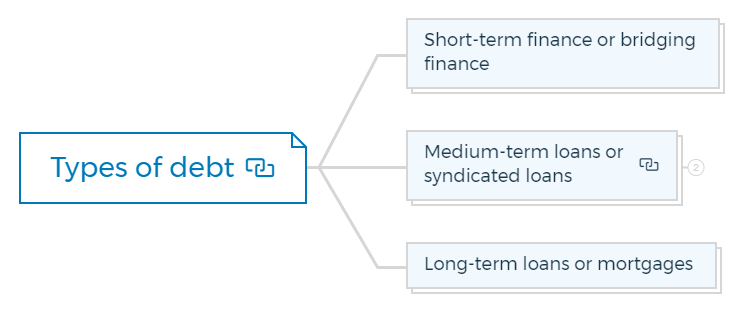
Short-term finance or bridging finance
This loan can be up to three years. Because interest is rolled up until the development is sold, the developer must pay both interest and principal at completion.
To do so, the developer would either sell the scheme or refinance the bridging finance using long-term loans.
Bridging finance is a complete funding package. A buyout replaces the interim funding offered at a rate somewhere between short-term borrowing and investment yield.
Bridging finance is often used for short term purposes such as six months or less to bridge the gap between the purchase of one property and the sale of another or to release equity while refinancing or selling another. Clearing banks and specialist lenders dominate the market.
Medium-term loans or syndicated loans
This is where multiple lenders come together to lend large amounts of money that would be too costly or risky for one lender. The lenders then diversify their loan book to include loans on multiple assets to reduce risk.
The lead banks arrange the loan and then syndicate it. The syndicating bank may not finance the loan, but the bank may charge fees for underwriting it.
Characteristics of a syndicated loan -
- The borrower's existing bank underwrites the loan and, in most situations, actually lends the funds.
- The loan agreement is written as an advance syndicated loan arrangement, allowing the original lending bank to transfer tranches of the original loan to other banks.
- The original lending bank's asset team then sell tranches of the loan in the banking market, acting as an agent bank.
The risk of investing in property syndication is higher than investing in a property trust, for example, because the purchaser will only own a single property rather than a portfolio of properties.
You can invest through various legal forms such as partnerships, incorporated joint ventures, or a unit trust structure.
The syndicate typically has a 5- to 10-year tenure. After which, the property is sold, and the net proceeds are distributed to the investors.
The following are the two types of syndicates:

Private syndicates
In this type of syndication, a small group of people, such as friends or business associates, band together to buy and develop real estate.
Public syndicates
Most public offers will necessitate preparing and filing a prospectus or information memorandum with ASIC by the promoter/developer or management.
The prospectus contains thorough information on the syndicate, development/risks investments, and potential rewards. Licensed securities dealers, property managers, financial advisors, and accountants may market the syndicate to the general public.
To be a successful developer, you must understand risk management in property development.
Long-term loans or mortgages
The mortgage term is generally between 10 and 25 years, with a maximum advance of two-thirds. Developers can choose to have a fixed or variable mortgage interest rate. There are also interest-only, repayment, and capital holiday options.
Lenders have the legal right to repossess the property if the borrower doesn't pay the interest and repay the borrowed money.
Corporate funding
There are two main areas of corporate funding: equity capital (or shares) and debt capital (or loans). Equity capital is paid into or kept in a business by the shareholders or owners.
It is long-term capital that entails the most risk and yields the best profits. Debt financing is money invested in a business by third parties, usually for a shorter period and with lower risk and return than equity.
Corporate finance is concerned with the company's financial structure. The key to financial management is choosing the right combination of debt and equity capital to meet the business's investment needs.
The following are some of the major sources of finance for any development firm receiving corporate funding:
- Shareholders' fund
- Retained profits
- Loan capital
How to finance your property development project?
The financing that a development entity (company, trust etc.) will use depends on the nature of the loan, whether long or short term. Clearing banks or, for larger firms, the stock market could be the source.
Funds are frequently secured on the project being done or by using other assets as collateral. Large businesses or projects can borrow or raise money by issuing bonds, shares, units or rights issues.
It's up to you to figure out which type of real estate financing is ideal for your situation. Watch this video below to get an overview of financing your development project.
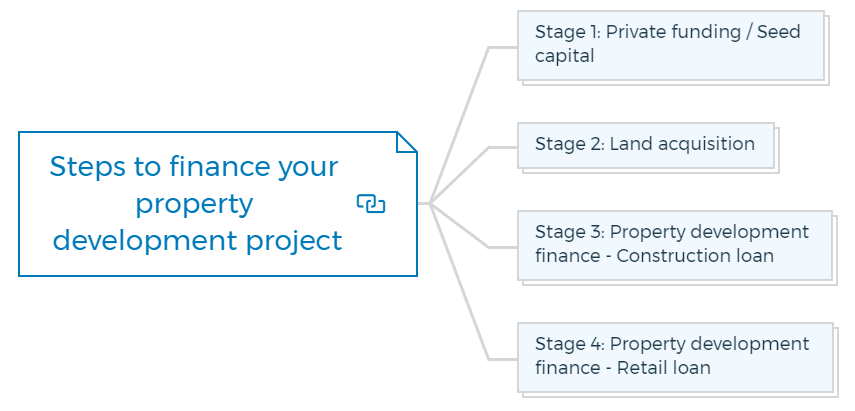
Stage 1: Private funding / Seed capital
- Usually required in the conceptual stage and funded by the property developer also known as developers equity.
- Covers the cost of consultants and more often than not will also need to cover the development approval soft costs or permitting costs.
- Everything required to put together a DA or Planning Permit Application.
- Reports
- Consultants
Stage 2: Land acquisition
- Usually a retail loan.
- Must have an existing house / dwelling on it for it to be a retail loan.
- Usually a Long term loan & can be both principal + interest as well as interest only with a shorter term.
- When purchasing just land - lender will only consider if it is part of a full development loan.
- Lenders do not like land banking loans.
- Land Sub-Division
- Lenders may require you to first secure the raw land with your own money.
Stage 3: Property development finance - Construction loan
- Interest only & often capitalized.
- Lenders may or may not finance GST/VAT costs.
- Interest is calculated on the drawn down amount.
Stage 4: Property development finance - Retail loan
- Develop & Hold
- Offset Account
- Line of Credit
Property development finance options
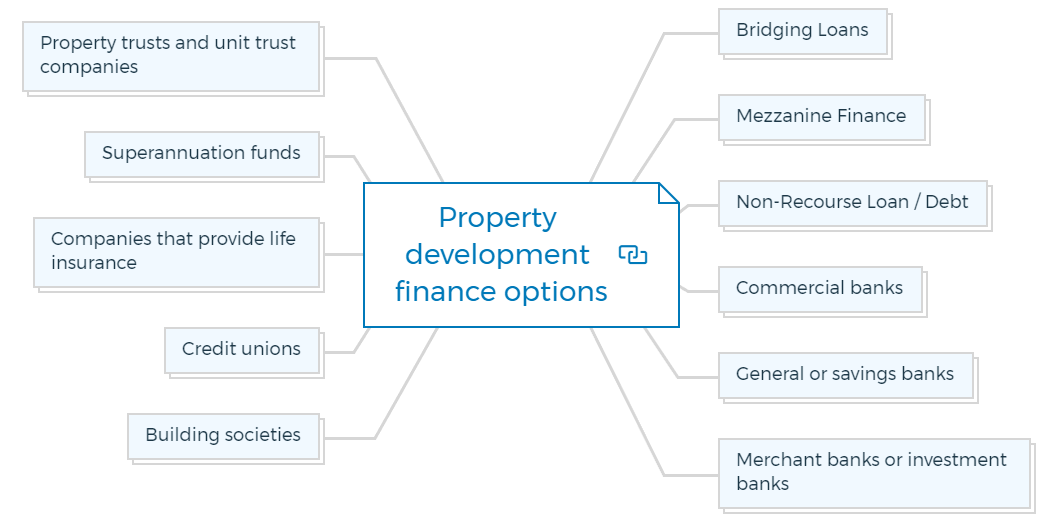
- Used to quickly move on a deal - more like not letting an opportunity pass by, so you developers often use a bridging loan and later refinance through another lender. Designed more to complete a transaction.
- Typically refinanced after a short-term with another lender.
- Comes at a higher interest rate
- Often used to obtain planning permits & cater to soft costs i.e. consultants, reports, permits etc.
- Comes from a specialized lender willing to take the extra risk & they would charge you a higher interest for taking that extra risk.
- Caveat Financing
- Debt Capital that gives the lender the right to convert to an ownership or equity interest in the company if the loan is not paid back in time & in full.
- Used by developers to secure additional financing for development projects, where there is a shortfall of equity required by the main or senior lender.
- More expensive - because it's secured by a 2nd mortgage. Since it's 2nd in line i.e. if something happens, 1st mortgage holder (senior lender) gets paid out first and then the second lender gets paid.
Non-recourse loan / debt
- Secured by collateral, real property, but the borrower is not personally liable.
- If the borrower defaults, the lender can seize the property pledged as security - but the lender's recovery is limited to that property i.e. the lender cannot come after the borrower even if the collateral does not cover the full defaulted amount.
- LVR is only 50-60% of Valuation.
Commercial banks
- Commercial banks specialize in mostly short-term commercial credit, focusing on liquidity than savings, and their appraisals are more conservative.
- The overdraft facility is one of the most common forms of short-term financing provided by commercial banks.
- In Australia, the National Australia Bank (NAB), the Commonwealth Bank of Australia (CBA), Westpac Banking Corporation, and the Australia and New Zealand Banking Group are prominent commercial banks in Australia.
General or savings banks
Depositors are the primary source of funding for general banks.
- General banks operate and participate in property finance the same way as building societies did previously.
- General banks handle the majority of residential property mortgages and suburban development.
Merchant banks or investment banks
- These individuals or institutions act as underwriters or agents for corporations, providing securities, investing advice, and facilitating corporate mergers and restructuring. Merchant banks are often also called investment banks.
- Essentially, merchant banks borrow money on the wholesale market and lend it to businesses and industries but not to the general people.
- Merchant banks can provide bridging and permanent capital finance for property development. However, they primarily focus on office and larger shopping center projects.
Building societies
- Building societies operate similarly to banks, with most of their funding coming from consumer deposits. These clients are building society members. 'Mutual societies' is a term used to describe building societies.
- Several building societies have amalgamated and diversified into health and travel insurance and business financing due to competition and a lower proportion of the house mortgage industry.
- Building societies do not have a set limit and will advance up to 90% of the property's value. The interest rates charged by building societies are equal to those charged by most banks.
Credit unions
- Credit unions are co-operatives owned and governed by the individuals who use their services.
- Each union member is both a shareholder and a client.
- Members' deposits are used to fund loans to other members.
Companies that provide life insurance
- These institutions are primarily interested in long-term investments with growth and capital appreciation.
- They are not interested in minor development initiatives because they receive substantial cash flows from contracted depositors (their policyholders).
- Insurance companies, on the whole, prefer to invest in completed developments by other developers at a predetermined price with guaranteed profits.
- Some more giant corporations have subsidiaries that will finance projects and then sell them to the parent corporation once completed.
Superannuation funds
- Superannuation funds are comparable to life insurance firms in terms of significant, reliable cash flows.
- These funds are typically invested in long-term real estate ventures that are profitable, stable, and potential to rise in value.
- Some superannuation funds are bound by the trust deed (a legal document that lays out the trust's rules and procedures) and may be limited to investing no more than 5% of the fund's value in any single project.
Property trusts and unit trust companies
- Property and unit trust businesses differ from managed fund operators, who deal primarily with stock portfolios and do not participate directly in the real estate market.
- Some unit trust businesses, such as property managed fund equities, solely invest in shares of property and construction companies listed on the stock exchange.
- These unit trusts have a portfolio of shares from various property development companies.
7 Tips to get financing for property development
Aspiring property developers need to be aware of the many ways they can finance their next project. From borrowing against their own home equity to securing government loans, there are a number of options available. Here are some tips to help you get financing for your property development project.

1. Give a sound economic justification for the loan
You may be looking for a loan to purchase an existing property or a property that requires a fresh spark in life that only you can provide. The purpose of the loan is crucial.
Commercial lenders want to feel confident that the loan's security will be financially stable and that the revenue disclosed or expected is accurate and realistic.
They prioritize knowing that the loan will be repaid when recommending it to their loan committee.
The calibre of your property investment team and the regional real estate market conditions will determine your estimates' credibility. Never rely on the lender's ignorance of the area's circumstances.
You must augment and reinforce their expertise by supplying thorough and precise data to support the income you anticipate receiving. One of the most acceptable methods is to have a triple-A-rated tenant sign a triple-net lease.
A triple-net lease is one in which the tenant is responsible for paying the rent and all expenses incurred to keep the property in good condition, such as taxes, insurance, and local assessments.
There are specific requirements for each loan, which the property lenders will insist you record. The rival properties in the same market region and a history of other existing and planned development that may impact your development project will all be shown in a property appraisal, which may also be necessary.
Any modifications to the local infrastructure that might have a positive or negative effect should also be displayed.
You must consider the lender's distance from the project. More background information will be required the further they are from the project.
There are numerous elements that your pro forma may not need to provide if the lender's office is located across the street from the project. However, you must presume that the lending committee will know little to nothing about the region if you work with an insurance firm 1,000 miles away.
2. Choosing the appropriate lender for your project
Assume you have been working on a project you are confident will be successful, such as an idea for a private student housing building close to two separate colleges.
You know that there is a dearth of nearby accommodation for students because you did your research with the personnel in charge of it at each of the two colleges.
Based on a 90% occupancy rate, your calculations show that the project will generate a 17% return on your expected capital investment.
Now all you need is a lender who believes that building student housing is worthwhile and will provide you with the necessary property development finance on the most favourable terms.
You need to shop around for a lender who loves anything that has to do with the educational atmosphere since you are starting without the lender's prior approval on what kind of projects they like to loan on.
The solution is relatively simple. Ask the student housing administrators again who they would advise you to contact for the property development finance.
Someone, somewhere between the two institutions and their respective housing offices, will offer a lender. It could be a bank whose president holds a position on both institutions' boards or is an alumnus of one of the colleges. Find a relationship between the colleges and the lender to contact by digging deep.
Naturally, there comes a time in every financing arrangement when the loan-to-value ratio is in the lender's favor and the property development loan amount might not be sufficient to cover the need for the loan.
You will have to shift categories or find other property financing options if you find yourself in one of these financing jams and the lenders are stubborn about a particular type of real estate.
Find an alternative when the first solution is no longer workable. Other sources of needed funding exist besides banks and savings and loans; on occasion, a private lender can come to the rescue.
Private lenders can be found wherever there are affluent people. You might also inquire whether someone you know who is affluent and in a position to know whether would lend money. Who is that, exactly?
It's good to start with your accountant, attorney, stockbroker, banker, or representative of the student housing system.
When someone gives you a recommendation about someone who provides residential development loans, try to learn as much as you can about that person.
Check the local society register if the person has lived in the area for some time. These social directories, which are occasionally offered for sale, contain many of the area's notable and wealthy residents.
Even the slightest background knowledge about someone might be helpful when you schedule your initial appointment.
Then set an appointment with a target you are optimistic you can achieve.
Don't ask for a property development loan on this initial visit. Do that only when you have successfully achieved your primary objective.
3. Establishing rapport before submitting anything
Almost everything you do in business follows a logical process like this. Either you show that you are the kind of person who would be a reasonable loan risk, or you ask friends or professional contacts to go ahead of you.
Having some of each factor working for you is typically a good idea. But be careful not to brag too much. It benefits you to appear and behave like a successful real estate investor.
It can be challenging to advance past this rapport level. The idea is to establish as high a level of contact as possible with the decision-makers, who are frequently concealed behind impenetrable barriers.
Building a solid relationship with the possible lender's secretary or personal assistant is one of the best methods to ensure you receive above-average treatment during the appointment stage and at subsequent meetings with the potential lender.
4. Use their forms and adhere to their guidelines
Every lender, even private lenders, typically have their papers that must be completed. Although they may all have similar appearances, they are not identical.
Do not bother lenders by filling out your forms that you might have copied from another lender because they know where to search on their forms to uncover essential information that you have filled in. It will endanger them, and you don't get the loan.
It's good to try to be as exact and concise as you can when filling out forms. Without being wordy, provide the reader with the necessary information.
5. Identify the amount you need to borrow
Include the amount that you need to borrow in the loan application. Asking your loan officer whether to indicate a net amount of loan charges or include the loan expenses in the overall loan is a good idea. Some lending committees prefer to do this, whereas others don't.
The loan committee will significantly weigh the property evaluation if you ask for an acquisition loan. Thus, the crucial loan-to-value ratio is established.
Because some lending regulations may impose different payback terms and interest rates, the closer the loan is to the property's value, this ratio is significant in single-family homes or small apartment buildings.
Different payback terms and interest rates may also apply to commercial loans, but this is typically due to the nature of the transaction rather than the rules governing lending.
6. Describe your property investment team
Create an investment team if you don't already have one. Because you chose this team, keep in mind that you can be evaluated on how successfully you assembled your property investment team by a lender and others.
Who are the members of this team? Naturally, they may vary based on the specifics of the transaction, but they will generally cover the four crucial areas from the lender's perspective: law, accounting, development, and management.
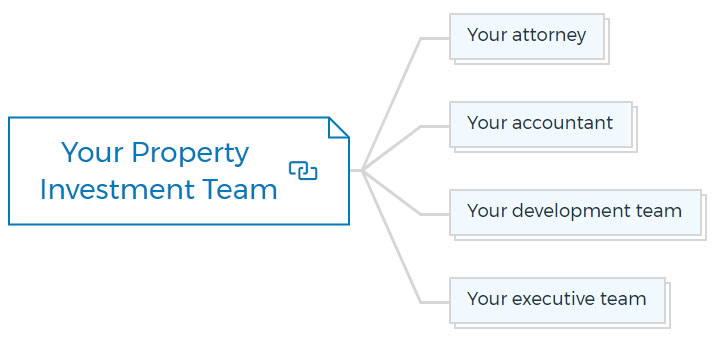
Your attorney
Is this person well recognized for being a real estate attorney? If not, regardless of how good a probate counsel you find, you made a poor decision.
The most significant name on the list is the attorney on your team. Your choice of legal representation reflects your desire to obtain excellence where it matters. Choose the person who best completes your team for the property development project or acquisition.
Your accountant
You should hire an accounting company with a solid national reputation. This company should focus on real estate accounting that corresponds to the property.
Your development team
Ensure you have information on the backgrounds of people you hire if you are not a general contractor or architect. Here, precise information on these team members that satisfy the lender's requirements may be required.
Your executive team
Do you have an internal management department, or do you contract out management? In either case, identify the department's chief and other employees.
A summary of their experience should demonstrate that you are skilled and qualified to manage the property more effectively through your decisions about the administration of your real estate assets.
7. Possess an optimistic and truthful personal resume

1. Be honest about your skills and experience
Don't inflate your qualifications or make things up; lenders can easily check the facts.
2. Take responsibility for your mistakes
If you've made some wrong decisions in the past, own up to them and explain what you learned from them.
3. Stay positive
Even if you've had some tough times in your life, focus on the lessons you've learned and how they've made you stronger.
4. Showcase your accomplishments
Instead of just listing your job duties, highlight the results you achieved in your previous roles.
Reasons why property developers fail to secure financing
Below are 3 main reasons why developers don’t get the financing for property development-
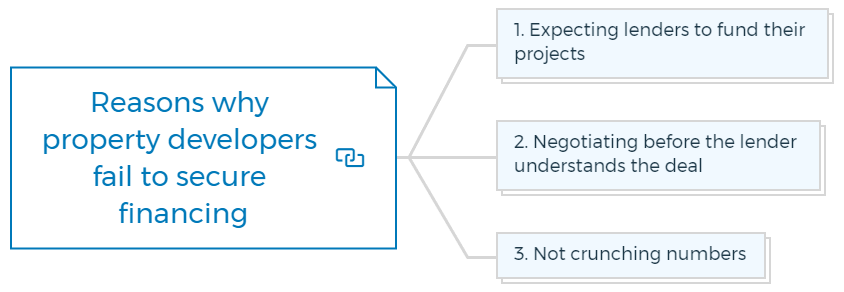
1. Expecting lenders to fund their projects.
Developers need to remember that getting finance from a bank or lenders is not an automatic process. Your loan may not be funded even if it meets lending policies and requirements. This is especially true if developers don't research the market's funding demand.
Lenders can become more discriminating when the number of good real estate projects coming across their desks increases. You must work smartly to convince the lender to be a part of your deal over the many others they are considering.
2. Negotiating before the lender understands the deal.
Everyone wants a good finance deal, but asking for, or even dictating, the terms you want before the lender knows anything about your project makes the process difficult.
Smart developers are patient and explain their motives, background, transaction specifics, and risk mitigation techniques first. Because of this, the lender will be motivated to offer competitive terms that reflect the risks and meet the deadlines.
3. Not crunching numbers
Elite property developers crunch their numbers repeatedly to guarantee their feasibility modeling is accurate. They often create their own spreadsheets to tweak pricing points, costs, and deadlines as they acquire more data and do more due diligence on the sale, and they never stop iterating the numbers.
People who are having trouble usually can't tell you their break-even point for each product, how much cash flow they need from now until the project is finished, or marketing details like cost per lead and conversion rates up to unconditional presale.
Know your numbers if you want to make a good impression on the lender and your broker.
Improve your ability to know your numbers well with Property Development Feasibility Suite With 4 Powerful Applications
FAQs


